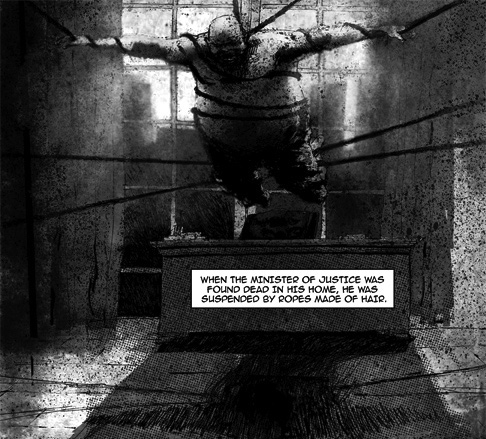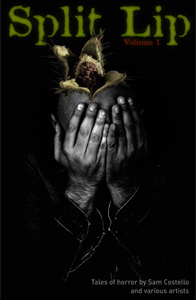In my first column about my experiences creating indie comics, I wrote about the importance of getting started. Starting is hard, but it’s critical to making comics, not just talking about making them.
If you can’t maintain momentum, though, you won’t get very far. This is something I learned the hard way writing Split Lip.
 When I launched the comic, I’d banked 6 or 7 scripts (maybe more), which formed a nice cushion. And for a while I was able to keep up with the workflow. I wrote scripts as ideas came to me and as I needed them, found artists and got work from them on schedule, and basically all was well.
When I launched the comic, I’d banked 6 or 7 scripts (maybe more), which formed a nice cushion. And for a while I was able to keep up with the workflow. I wrote scripts as ideas came to me and as I needed them, found artists and got work from them on schedule, and basically all was well.
Until late 2008. That’s when a combination of me being busy, scripts stalling in various stages of production, and flagging momentum created a dry spell at Split Lip. We published not a single new page from January to July 2009. In the world of webcomics, where many strips are updated three times a week, an unscheduled six-month hiatus is basically the same as ending your comic.
And though we’ve made it back since then, I know we lost readers and momentum.
After that I truly understood the value of momentum. I should have known – Newton’s second law of motion tells us that objects in motion tend to stay in motion, and that objects at rest tend to stay at rest. And boy howdy do comics obey the laws of motion.
To prevent that kind of outage from ever happening again, I came up with these insights that I use to keep motivated and – most importantly – productive.
Time is the one thing I can’t get back – We all know this is true, but it wasn’t until I started living that way that it began to really make sense. Knowing that I truly can’t get back my lost time makes the decision to play video games or make comics, to watch a movie or make comics, much easier.
Horde time jealously – Because I can’t get back my time, I’m protective of it. When I sit down to write comics, that’s what I’m doing. I don’t take phone calls (unless they’re emergencies), don’t check email, I go places I won’t see anyone who wants to talk to me, and schedule to allow for writing time. If I don’t, my time will be chipped away without anyone knowing it’s happening. It may sound antisocial, but it’s not. But it means I’ve had to decide what I value.
Be less interruptible – When it comes to making comics, I’m lucky: I live alone; I’m less likely to be interrupted. But if you have a roommate, family, whatever, you have to make it clear that you can’t be interrupted when you’re making comics. I learned this when I had roommates. They’d see I was at the computer, but didn’t understand that I was writing, not secretly waiting for them to come talk to me. Productivity studies have shown it can take up to 30 minutes to return to your previous level of productivity and engagement after an interruption. That’s a lot of lost time. Don’t be interruptible when you’re making comics; you’re working.
Carve out time – Setting a regular schedule and sticking to it is crucial. If you don’t, you’ll find there are more reasons not to make comics than to make them. It’s just the nature of the world. Can you get an hour every Monday night? Two hours on the weekend? 45 minutes every Tuesday and Thursday? That’s where you start. I generally use Tuesday and Thursday afternoons, an hour to two hours each time. In the winter, I add Friday afternoons (in the summer, I enjoy the weather). I’ve found that if I don’t carve the time out of my schedule, I’m not able to produce enough to maintain momentum.

Do Something Every Day – Even if it’s just spending 10 minutes posting a comment with the URL in it, sending out a press release, writing a little bit of script, making a banner ad, emailing a reviewer, doing something related to Split Lip every day has been crucial for me. It’s hard, but it helps. I’d be lying if I told you I was able to truly do something related to Split Lip every day, but that’s my guideline. Do something every day and you maintain momentum, gain speed, and put yourself in the position to succeed.
Staying Positive – This is maybe the hardest part – it certainly is for me. It’s hard to stay positive during years of limited success. I’ve thought about quitting a few times over the years. Stagnant readership. Two-day cons where you sell 5 books. Artists who disappear with money and without providing any art. It’s hard, it hurts, and it makes you want to stop. I stay positive by looking at the work my artists and I have done. I re-read our stories, flip through the books. Seeing work that I think is good cheers me up, keeps me going. You’ll find other things that work for you, I’m sure, but find something. Otherwise it’s too hard to keep going.
This is what I do to keep making comics. I haven’t produced as much as I’d like to, or should have, in my four years of creating Split Lip. But 500 pages and 30-plus stories feels pretty good. And it keeps me going.
If you want to make comics, you’ll have to find a way to keep yourself going, too. If you stop, your momentum is broken. You’ll have to start again. And remember how hard starting was the first time?


Great article. I have to agree with you that momentum is SOOOO important in any sort of creative endeavor whether its comics or something else. You’re totally right, that its very easy to get derailed and starting up again can be a grueling and frustrating process. Especially with art, things like drawing can be a "use it or lose it" skill. While your talent may not go away, your ability to confidentally use it might.
How much of a buffer of completed pages would you advise a creator to have if they were starting their own web comic?
I love that you are doing this series, very insightful. thanks
Thanks guys. Glad you’re enjoying this and that I can sneak through amid all the SDCC news.
@Wally – The size of the buffer depends on a lot of things. For instance, how often do you post, how fast do you work, is it just you or do you depend on collaborators, etc. If you’re going to do a Mon-Wed-Fri update schedule (which is pretty common for a strip-style webcomic), I’d try to have at least a month – 12 strips – in buffer. Ideally there would be more, but that’s a decent cushion.
If you’re posting on another schedule, I’d try to have more. For instance, I’ve got 4 Split Lip stories being drawn right now for a total of 60+ pages of comics. Having a a lot of stories in process helps keep the pages flowing.
If you’re thinking about starting a webcomic, I’d strongly recommend joining Webcomics.com, which is a relatively new professional development and networking site for webcomics creators. They address this issue – and a lot more – regularly. It’s $30/year, but you’ll get waaaaaay more value (and discounts) out of it than that. I love the site.
Thanks for these tips and for doing this series of articles. I’ve been checking out your site and stories. Good stuff.
@sam–great tip on that website. Since most of it is locked down to membership, is the crowd of creators pretty diverse on there? I found there was a lot of mention of "cartoonists"and comic strips in the public forums. Are there more of the graphic novel types on there as well?
Keep the great articles coming!
@wally – Yeah, it’s pretty diverse. There are probably more people creating strip-style comics, and more people who are both writer and artist on their comic, but there’s a decent number of GN-type creators, or writers only. I definitely find it valuable.